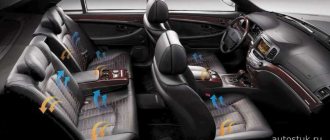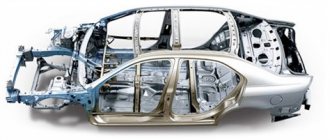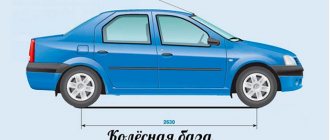Many novice drivers are interested in the question of what car restyling is, why it is needed and “what it is eaten with.” In simple terms, this concept means making changes to the appearance of the car. In Russia, many people call restyling the word “tuning”, although these terms differ in meaning. In the first case, changes are made to the interior and exterior of the car, and tuning is considered to be an improvement in the technical equipment of the car. There are other concepts that characterize making adjustments to a car in such a way that a more aggressive shape of the car appears. In this material it is worth considering the concept of restyling in more detail.
What is car restyling
Using restyling, the manufacturer makes minor adjustments to the appearance of the car to refresh the current generation model.
Restyling means changing some elements of the car body so that the vehicle looks different without fundamental changes. A similar term that is applied to this procedure is facelift.
Often, to update the current model, automakers resort to major changes to the interior. There are also cases when, as a result of a facelift, a car receives deep body updates. For example, a car becomes more lowered than the main model or receives a new part (spoiler or sports body kits). With all these changes, the model name does not change, but if you put these cars next to each other, the differences are immediately obvious.
Attitude towards restyling
In general, car owners have a positive attitude towards restyling. It cannot be underestimated in the modern world, when everything is developing very rapidly. In addition, this procedure allows you to eliminate problems identified after the release of the first modification of the car. Due to this, the model is improved. You need to understand that restyling is just a changed appearance. It does not affect technical characteristics. The same processes occur in manufacturing matters, when equipment is improved every 3-5 years in order to move forward and keep up with competitors.
Why restyling is needed
In the automobile market, a lull is always identical to the collapse of a company. For this reason, manufacturers closely monitor the relevance of the technical content of their products, as well as the popularity of the model range. Usually, 5-7 years after the release of the next generation, it will become commonplace and lose the interest of buyers.
So why have we been hearing more and more recently about the release of an updated version of a famous car?
Reasons for restyling
As strange as it may sound, the auto world also has its own fashion and style. And these trends are closely followed by designers and engineers of all self-respecting companies. An example of this is the birth of the VAZ 21099 modification.
In those distant times, the famous “eight” and its restyled version, the “nine,” met the needs of the younger generation, who wanted to have an inexpensive car, but with sporty characteristics (at that time). However, in order to also satisfy the needs of sedan lovers, it was decided to develop a new, also restyled version, a model based on the 09, but in a sedan body. Thanks to this decision, the car became an icon of style and significance among the generation of the 90s.
Another reason for such model updates in the market is competition. Moreover, it greatly speeds up the process of the appearance of restyled models. Some brands try to keep up with customer needs, while others set the pace, constantly raising the bar to the next level.
Often it takes no more than three years to develop and release a new generation model or facelift version. Even the most popular car can maintain its position precisely thanks to this marketing ploy.
In this regard, a completely logical question arises: why waste time and resources on restyling, and then release a new generation a couple of years later? It would be much more logical to immediately release a new generation of cars.
The answer here lies not so much in logic, but rather in the material side of the issue. The fact is that when a model is at the development stage, a lot of licenses and technical documentation need to be collected for a new car. Engineering developments, licenses for new powertrains and electronic systems all require investment.
When the next model is released, sales of the previous modification must cover not only the costs of obtaining the appropriate approvals, but also the salaries of the company's employees. If you take this step every three years, the company will operate in the red. It is much easier to set the machines to a different mode and slightly change the body design or install new optics - and the car looks more modern, and the client is satisfied, and the brand can keep the model in top positions.
Essentially the same thing happened with the aforementioned 99th. The management of the domestic manufacturer decided not to give a new number to the new product, so as not to change the technical documentation, but simply added another nine to the model name. This resulted in an almost new model, but with the characteristics of an already popular car.
As mentioned above, many automakers would be happy not to invest in changing the appearance of their cars. But due to the increasing popularity of specific styles or technical data, they are forced to resort to this scheme. Often, internal rebranding is even carried out (the logo, icon and sometimes even the brand name are changed to reflect the new concept of the company), because the competition is unsettling.
What does the concept of restyling include?
Essentially, these are any innovations that in one way or another draw a line between a younger model and its predecessor, and also slow down the car’s obsolescence. Restyling can be anything. In some cases it is barely noticeable, while in others it represents numerous large-scale improvements of both a stylistic and technical nature. Rejuvenation allows cars to stay on the production line for another couple of years, although sometimes it’s time to talk about a much longer period.
Types of car restyling
As for the types of restyling, there are two types:
- External renewal (often this type is called facelift - “facial skin tightening” or rejuvenation);
- Technical restyling.
Stylistic restyling
In this case, the company's designers are developing various modifications to the appearance of an existing model in order to give it freshness. Most often, brands resort to this type of update. Typically, manufacturers limit themselves to minor implementations that subtly hint that the car has received updates.
And sometimes designers get so carried away that the body even gets a separate numbering, as often happens with Mercedes-Benz and BMW cars. Less common is a significant change in appearance, since this procedure also requires funds and resources. The update may also include changes to the interior. Moreover, more often it undergoes much more changes than the body part.
Here is a small example of a minor restyling of a car:
Kia Rio: minimal restyling
Technical restyling
In this case, the procedure is often called homologation. This is a change in the technical part, but also without significant changes, so that the result is not a new model. For example, homologation includes expanding the range of engines, making some adjustments to the power units or electronics of the car, which improves its performance.
For example, some Ford models were not initially equipped with EcoBoost engines, but after restyling, such modifications become available to customers. Or in the period 2003-2010. The BMW 5-Series in the E-60 body received turbocharged analogues instead of naturally aspirated engines. Often such changes are accompanied by an increase in power of a popular model and a decrease in fuel consumption.
Often such “rejuvenation” is carried out several times during the production history of a model of one generation. Often technical restyling borders on the release of a new generation. An example of this is the two homologations of the Mazda 3. In addition to impressive cosmetic procedures, engines and even the chassis were changed. However, this is not the limit that the manufacturer can afford.
Can I do it myself?
Many drivers confuse restyling with tuning. These are two completely different concepts. Many people think that it is impossible to carry out restyling on their own, since this is done by manufacturers. But this is a misconception. Do-it-yourself facelift is the best way to modernize the appearance of your car.
For example, many drivers trim the interior with carpet. This is an inexpensive material available in different colors. It is often used by manufacturers themselves. If desired, the driver can combine shades by covering the subwoofer, acoustic podiums and sometimes doors with carpet. Various items inside the cabin are upholstered in elastic Alcantara. It is also available in different colors. It can be replaced with flock, but this is an impractical fabric that collects dust and dirt.
To change the exterior of the car, drivers purchase carbon film. This is carbon fiber, which is used to paste the body without outside help. There are also chrome films, but it is better to finish the body with it in specialized centers. The cheapest type of facelift using film is considered to be pasting with matte material. Along with it, vinyl film, which is a competitor to airbrushing, is in demand.
For many drivers, it is important that changes to the car occur without strong intervention. For example, do-it-yourself window tinting is the most common type of facelift. Sticking it on is not as difficult as it seems at first glance. The same goes for painting wheel rims or installing additional devices into the system. We can say that restyling is an inexpensive pleasure if you choose the right materials.
Why do car brands restyle cars?
In addition to the need to maintain the brand’s clientele, a company may resort to restyling for another reason. Everyone knows that technology does not stand still. New programs, new equipment and entire systems are constantly appearing that can make not only a car more attractive, but also safer and more comfortable.
Of course, it is rare when a car receives a significant equipment update during restyling. Such an update is often left as an afterthought when generations change. But if the model used standard optics, then during restyling the light may receive a more modern update. And this not only affects the appearance of the car, but also makes it more comfortable and safe to drive. If the car uses better quality light, the driver can see the road well, which is less tiring and safer, since the road is clearly visible.
Kinds
As soon as the driver understands the essence of what restyling means in a car, he goes deeper into this concept. Today there are two types of restyling:
Planned - happens most often, since even the most modern and attractive car model loses relevance over time. Competitive companies are fighting for customers, so they offer more interesting options. Planned restyling forces manufacturers to release updated car models in order to retain customers.
Unscheduled - carried out in order to maintain sales of a specific car model. For example, after the car was released, buyers criticized its appearance, build quality, or commented on its ease of use. Manufacturers, in order to somehow justify themselves to customers, solve the problem through restyling.
Thus, restyling means an intermediate update of a car model. Specific changes occur when a generation changes (every 7-10 years).
What changes in a car during restyling?
Often during restyling, changes are made to some parts of the body. For example, the geometry of the bumper, radiator grille and optics may change. The shape of the side mirrors may also change, and additional elements may appear on the trunk lid and roof. For example, designers can add a modern shark fin antenna or spoiler to the model.
To interest buyers, the car manufacturer can offer a choice of a set of wheel rims with different designs. A restyled car is also recognized by a modified exhaust system, for example, in the pre-restyling version, one exhaust pipe was used, and after restyling, a double pipe or even two exhaust pipes may appear on both sides of the bumper.
Much less common, but still occurring, is a change in the design and geometry of doors. The reason is that developing a different door design may require changing their design, which is sometimes also costly.
Additional decorative elements may also appear on the exterior of the restyled model, for example, moldings on the doors, or the buyer may be offered additional body colors. Three years after the start of production of the model, the manufacturer may slightly refresh the interior design (for example, the style of the center console, dashboard, steering wheel or upholstery will change).
As a rule, when restyling, the manufacturer changes the front part of the car and can only slightly change the style of the rear of the car. The reason is that, first of all, buyers pay attention to the front of the car they are buying in order to appreciate its beauty.
Tips on what to look for when purchasing
When purchasing a car on the secondary market, it is worth taking a closer look at the general condition of the car. It is expressed both in the appearance and safety of the body, and in the operation of the gearbox, suspension and trunk locks.
But I would like to separately note the operational points:
- increased oil consumption is possible closer to one hundred thousand km, especially during active movement;
- all engines, and these are 1.6, 1.8, 2.0 liters, are very demanding on fuel quality, and it doesn’t matter which brand they prefer to refuel with 92 or 95;
- Shifts on an automatic transmission should be smooth. To check, you need to accelerate sharply and release the accelerator pedal;
- creaking in the rear suspension - a call about the need to replace the “floating” silent blocks;
- Manufacturer's warranty for resistance to continuous corrosion is 12 years. Detection of any “saffron caps”, “spiders”, or swelling of paint is a guarantee of low-quality repairs after an accident.
What, as a rule, does not change during restyling?
When a restyled model comes out, it is clear to the buyer that he is buying a model of a specific generation with some stylistic changes. The reason is that the architecture of the entire body remains the same. The manufacturer does not change the geometry of door and window openings.
The technical part of the car does not change either. So, the power unit (or the list that was offered for this model) remains the same. The same goes for the transmission. The roof, fenders and other important body elements do not change mid-production, so the car's length, ground clearance and wheelbase remain the same.











